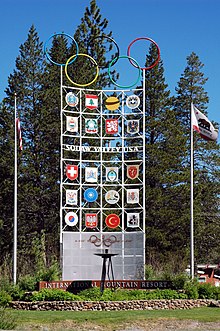Squaw Valley is a ski resort town on the border between California and Nevada area centered around Lake Tahoe. Squaw Valley Ski Resort covers 3,600 acres (15 km²) employing 30 chairlifts and the only funitel in the U.S. It is the second-largest skiing complex in the Lake Tahoe area after Heavenly Mountain Resort. It is best known for hosting the 1960 Winter Olympics.
Understand
[edit]The existence of Squaw Valley as more than a dot on the map is heavily tied to the 1960 Winter Olympics. Wayne Poulsen, president of the Squaw Valley Development Company, convinced then California governor Goodwin Knight to support a bid by Squaw Valley to host the 1960 Winter Olympics and the governor did so, asking his state legislature to appropriate a million dollars for that purpose.
In 1955 the bid was officially submitted to the IOC (at the time led by the American Avery Brundage) who accepted the bid much to the chagrin of established winter sports destinations like Innsbruck Chamonix and St. Moritz which had also bid, but the IOC warned that the hosting rights would be reassigned if the U.S. did not invest further money into local facilities. The California state legislature committed another four million dollars and thus Brundage confirmed the hosting rights for Squaw Valley.
The task now was to turn what was a resort of one chair lift, two rope tows and a fifty room lodge in 1956 into an Olympic class winter sports destination. Local boosters sold this apparent disadvantage as a plus, arguing that this "blank canvas" allowed them to build a resort perfectly in line with the demands of the 1960 Olympics. Just how small a place Squaw Valley was, was underscored when during the 1956 Winter Games in Cortina d'Ampezzo the traditional ceremony of the mayor of the previous host ceremoniously handing over the baton to the mayor of the next host had to use a random IOC member from California to stand in for the - not yet existing - mayor of Squaw Valley.
Ultimately the games cost some eighty million dollars all told (of which a quarter came from the federal government) and Squaw Valley had a lot of state of the art facilities - including the first Olympic Ice Rink to use artificial ice. However, as a cost cutting measure and because only 9 nations wanted to send competitors in that sport, bobsledding was left off the Olympic schedule that year to avoid having to build a venue - bobsledding had been an Olympic event at every prior Winter Games and would remain so into the 21st century. The games were the first to be shown live on U.S. television (the 1956 games had been shown by some European broadcasters) and while the broadcasting rights were sold to CBS for only $50,000, that figure would soon jump tenfold for the same year's Summer Games.
In August 2020, the owners announced their commitment to remove the word “squaw” from the resort's name by summer 2021 as the use of the term is an ethnic and sexual slur.
Get in
[edit]Squaw Valley is found off California State Route 89, about 12 miles south of Truckee at the intersection of CA-89 and Interstate 80. The closest city with a major airport is Reno, Nevada, about 32 miles east of Truckee on I-80.
Get around
[edit]Squaw Valley Road is the main arterial. It runs roughly east-west and feeds into California State Route 89 at its eastern end.
See
[edit]


Do
[edit]- 1 Squaw Valley, ☏ +1 530 583-6985. On Highway 89 between Tahoe City and interstate 80; Squaw is possibly the most well-known resort in all of California, and the setting for the 2006 book Squallywood. A complete skier's paradise, Squaw is a magazine favorite for its varied terrain, huge size and massive high-speed lift system; and a former Olympic village. Its oversized reputation has a downside: crowds that even a on mountain the size of Squaw can swamp the intermediate lifts and result in lines.
- G.N.A.R.. A way of life for many of the skiers at Squaw, G.N.A.R. is a points-based game whereby each skier gains points by skiing particular lines through Squaw's famous terrain, with many interesting bonus points available. Grab a copy of Squallywood if you are up to the challenge of some of the best lines Squaw has to offer, and a great game while you're at it.
Buy
[edit]Eat
[edit]- Graham's. Located near the mountain parking lot, delicious food, extensive wine list, ambiance is a little more staid, but recommended none-the-less.
- PlumpJack. One of the oldest and most established restaurants in the area, it serves typically Californian food Plumpjack has a sister restaurant in San Francisco, as you might expect though it is quite expensive.
Drink
[edit]- Auld Dubliner, 1850 Village S Rd, ☏ +1 530 584-6041. The place for a perfect pint of Guinness, this real Irish pub was built in Ireland, dismantled, shipped over and reassembled. As one might imagine, it offers a wide selection of whisky and live Celtic music.
Sleep
[edit]- Squaw Valley Lodge, 201 Squaw Peak Rd, Olympic Valley, toll-free: +1-800-549-6742. Squaw Valley Lodge is an all condominium suites hotel resort.
- Plumpjack Squaw Valley Inn, 1920 Squaw Valley Rd, toll-free: +1-800-323-7666. Squaw Valley Inn has 58 rooms and suites with amazing views. Shop at their Fashion Boutique and take their wine seminars.
- Resort at Squaw Creek, 400 Squaw Creek Rd, Olympic Valley, ☏ +1 530 583-6300. A premier all season mountain resort featuring a luxury spa facility, ski packages, championship golf courses, vacation rentals, and a dedicated chairlift.
Connect
[edit]Go next
[edit]- Other resorts and parts of Lake Tahoe
- Reno, the closest large city
- Sacramento, the capital of California


